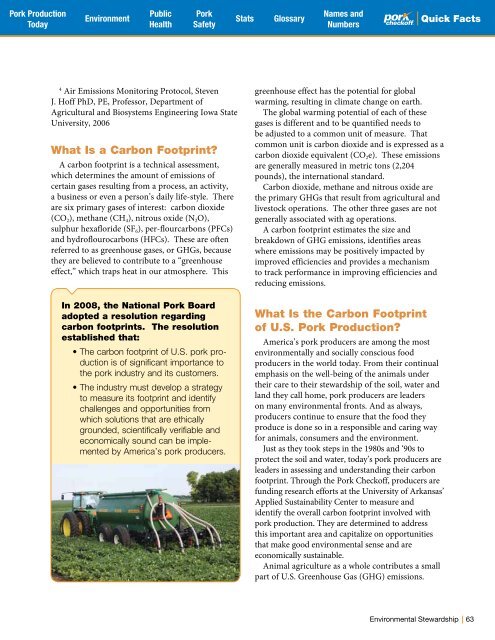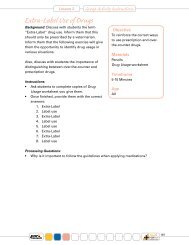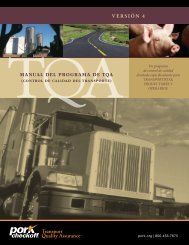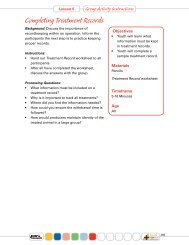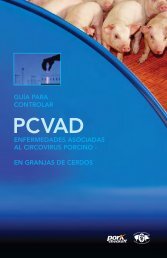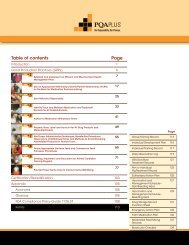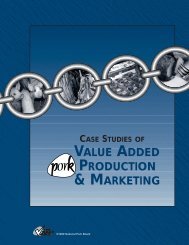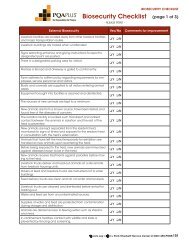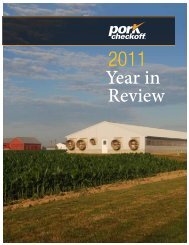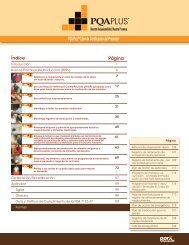The Pork Industry at a Glance - National Pork Board
The Pork Industry at a Glance - National Pork Board
The Pork Industry at a Glance - National Pork Board
Create successful ePaper yourself
Turn your PDF publications into a flip-book with our unique Google optimized e-Paper software.
<strong>Pork</strong> Production<br />
Public<br />
<strong>Pork</strong><br />
Names and<br />
Environment<br />
St<strong>at</strong>s<br />
Glossary<br />
Today Health Safety Numbers<br />
Quick Facts<br />
Quick Facts<br />
4<br />
Air Emissions Monitoring Protocol, Steven<br />
J. Hoff PhD, PE, Professor, Department of<br />
Agricultural and Biosystems Engineering Iowa St<strong>at</strong>e<br />
University, 2006<br />
Wh<strong>at</strong> Is a Carbon Footprint?<br />
A carbon footprint is a technical assessment,<br />
which determines the amount of emissions of<br />
certain gases resulting from a process, an activity,<br />
a business or even a person’s daily life-style. <strong>The</strong>re<br />
are six primary gases of interest: carbon dioxide<br />
(CO 2 ), methane (CH 4 ), nitrous oxide (N 2 O),<br />
sulphur hexafloride (SF 6 ), per-flourcarbons (PFCs)<br />
and hydroflourocarbons (HFCs). <strong>The</strong>se are often<br />
referred to as greenhouse gases, or GHGs, because<br />
they are believed to contribute to a “greenhouse<br />
effect,” which traps he<strong>at</strong> in our <strong>at</strong>mosphere. This<br />
In 2008, the N<strong>at</strong>ional <strong>Pork</strong> <strong>Board</strong><br />
adopted a resolution regarding<br />
carbon footprints. <strong>The</strong> resolution<br />
established th<strong>at</strong>:<br />
• <strong>The</strong> carbon footprint of U.S. pork production<br />
is of significant importance to<br />
the pork industry and its customers.<br />
• <strong>The</strong> industry must develop a str<strong>at</strong>egy<br />
to measure its footprint and identify<br />
challenges and opportunities from<br />
which solutions th<strong>at</strong> are ethically<br />
grounded, scientifically verifiable and<br />
economically sound can be implemented<br />
by America’s pork producers.<br />
greenhouse effect has the potential for global<br />
warming, resulting in clim<strong>at</strong>e change on earth.<br />
<strong>The</strong> global warming potential of each of these<br />
gases is different and to be quantified needs to<br />
be adjusted to a common unit of measure. Th<strong>at</strong><br />
common unit is carbon dioxide and is expressed as a<br />
carbon dioxide equivalent (CO 2 e). <strong>The</strong>se emissions<br />
are generally measured in metric tons (2,204<br />
pounds), the intern<strong>at</strong>ional standard.<br />
Carbon dioxide, methane and nitrous oxide are<br />
the primary GHGs th<strong>at</strong> result from agricultural and<br />
livestock oper<strong>at</strong>ions. <strong>The</strong> other three gases are not<br />
generally associ<strong>at</strong>ed with ag oper<strong>at</strong>ions.<br />
A carbon footprint estim<strong>at</strong>es the size and<br />
breakdown of GHG emissions, identifies areas<br />
where emissions may be positively impacted by<br />
improved efficiencies and provides a mechanism<br />
to track performance in improving efficiencies and<br />
reducing emissions.<br />
Wh<strong>at</strong> Is the Carbon Footprint<br />
of U.S. <strong>Pork</strong> Production?<br />
America’s pork producers are among the most<br />
environmentally and socially conscious food<br />
producers in the world today. From their continual<br />
emphasis on the well-being of the animals under<br />
their care to their stewardship of the soil, w<strong>at</strong>er and<br />
land they call home, pork producers are leaders<br />
on many environmental fronts. And as always,<br />
producers continue to ensure th<strong>at</strong> the food they<br />
produce is done so in a responsible and caring way<br />
for animals, consumers and the environment.<br />
Just as they took steps in the 1980s and ‘90s to<br />
protect the soil and w<strong>at</strong>er, today’s pork producers are<br />
leaders in assessing and understanding their carbon<br />
footprint. Through the <strong>Pork</strong> Checkoff, producers are<br />
funding research efforts <strong>at</strong> the University of Arkansas’<br />
Applied Sustainability Center to measure and<br />
identify the overall carbon footprint involved with<br />
pork production. <strong>The</strong>y are determined to address<br />
this important area and capitalize on opportunities<br />
th<strong>at</strong> make good environmental sense and are<br />
economically sustainable.<br />
Animal agriculture as a whole contributes a small<br />
part of U.S. Greenhouse Gas (GHG) emissions.<br />
Environmental Stewardship<br />
63


